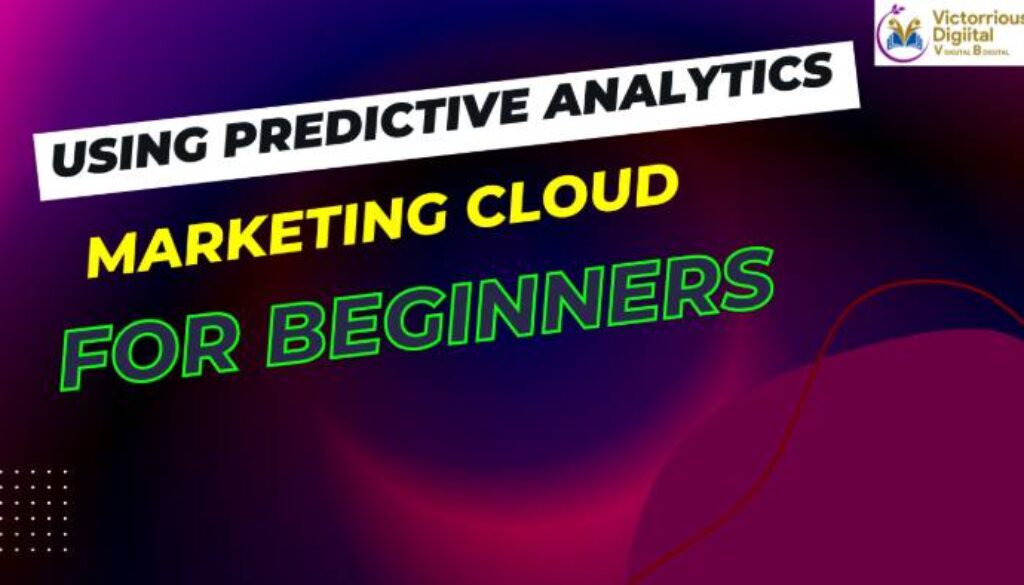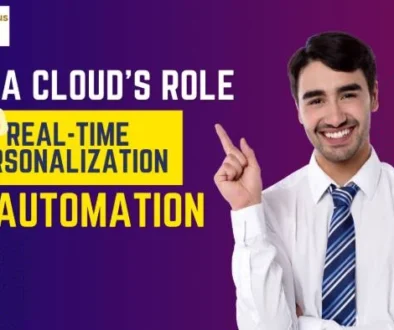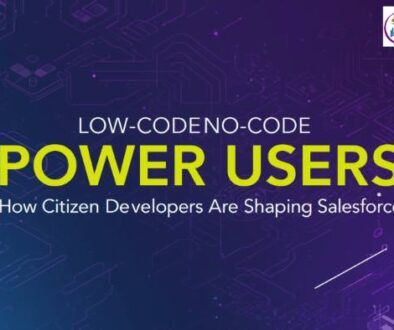Using Predictive Analytics in Marketing Cloud
Understanding your customers’ behavior and predicting what they might do next is incredibly valuable for a business. Wouldn’t it be great if you could anticipate which customers are most likely to buy from you or which leads will be interested in your products? This is where predictive analytics comes in.
In this blog, I’ll explain predictive analytics, how it works within Salesforce Marketing Cloud, and how you can use it to improve your marketing efforts. Whether you’re a beginner or someone exploring new opportunities, this blog will break it all down so you can start leveraging this powerful tool. If you’re interested in learning more, consider joining Salesforce Marketing Cloud classes in Pune, enrolling in the best Salesforce Marketing Cloud course in Pune, or exploring online Salesforce Marketing Cloud classes.
Table of Contents
What is Predictive Analytics?
Predictive analytics is the use of data, statistical algorithms, and machine learning techniques to identify the likelihood of future outcomes based on historical data. In simple terms, it’s about predicting what will happen next by analyzing what has already happened.
In the context of marketing, predictive analytics helps businesses forecast customer behaviors, trends, and sales patterns. For example, it can tell you:
- Which customers are likely to open your emails?
- Which leads are more likely to convert into paying customers?
- When a customer might be ready to make a purchase.
This can drastically improve your marketing strategies, allowing you to tailor your messages and offers to the right people at the right time.
How Does Predictive Analytics Work in Salesforce Marketing Cloud?
Salesforce Marketing Cloud offers powerful tools that allow you to implement predictive analytics and gain deep insights into your marketing data. The platform uses Artificial Intelligence (AI) and Machine Learning (ML) models to predict customer behavior. These models are built based on your historical data, which can include customer interactions, preferences, purchase history, and more.
With Salesforce Marketing Cloud, you can use predictive analytics in several ways to boost your marketing campaigns:
- Predictive Engagement: Predictive engagement helps you understand how a customer is likely to interact with your brand based on their past behavior.
For example, if a customer tends to click on certain types of emails or visit your website at specific times, predictive analytics can suggest the best time to send them a follow-up email or offer.
This can help you engage with customers in a way that feels personal and timely, increasing the chances of them interacting with your brand.
- Predictive Audiences: Salesforce Marketing Cloud can help you build predictive audiences by identifying patterns in your customer data. Based on past behavior, the platform can predict which customers are most likely to respond to your emails or offers. This means you can send targeted messages to the right people, leading to higher engagement and conversions.
For instance, if you are running an online Salesforce Marketing Cloud training course, predictive analytics can help you identify which leads are most likely to enroll based on their previous actions and interests.
- Predictive Scoring: Predictive scoring assigns a score to each customer or lead based on their likelihood to take a specific action, like making a purchase or clicking a link. This score is calculated using machine learning models that analyze customer behavior and engagement patterns.
You can use this score to prioritize high-value leads. For example, if someone has a high predictive score, you may choose to send them a personalized offer, while low-scoring leads might be sent a different message to encourage engagement.
- Churn Prediction: Churn prediction helps you identify customers who are at risk of leaving your brand. By analyzing past behavior, Salesforce Marketing Cloud can predict which customers are most likely to stop engaging with your brand or unsubscribe from your emails.
Once you know which customers are at risk of churning, you can take proactive measures, such as sending them special offers, re-engagement emails, or targeted content to keep them interested in your products or services.
How to Use Predictive Analytics in Salesforce Marketing Cloud
Now that we know what predictive analytics is and how it works, let’s explore how you can use it in Salesforce Marketing Cloud for your business. Here’s a step-by-step guide:
Step 1: Collect Your Data: The first step in predictive analytics is gathering data. The more data you have about your customers, the better your predictions will be. Salesforce Marketing Cloud automatically collects data on customer interactions with your brand, such as:
- Email opens and clicks.
- Website visits.
- Purchases.
- Social media interactions.
You can also integrate data from other sources like customer surveys or CRM systems to get a more complete picture of your audience.
Step 2: Build Predictive Models: Once your data is ready, Salesforce Marketing Cloud uses machine learning algorithms to build predictive models. These models analyze the data and find patterns or trends that can help forecast future behaviors.
For example, if you’re running a Salesforce Marketing Cloud training institute in Pune, you can build a predictive model to identify which leads are most likely to sign up for your Salesforce Marketing Cloud courses in Pune based on their interactions with your website, emails, and other marketing materials.
Step 3: Use Predictive Insights: Salesforce Marketing Cloud provides you with actionable insights derived from the predictive models. These insights help you make smarter decisions about your marketing strategy. For example:
- If predictive analytics shows that a certain segment of customers is more likely to purchase a product, you can send them targeted emails or offers.
- If a customer is predicted to churn, you can send them an incentive to stay engaged.
These insights give you the ability to make data-driven decisions that improve the efficiency and effectiveness of your marketing campaigns.
Step 4: Automate Your Campaigns: Once you have your predictive insights, you can automate your campaigns in Salesforce Marketing Cloud.
For example, if predictive analytics suggests that certain customers are more likely to buy a product, you can set up an automated email campaign to send them personalized offers at the right time.
This automation saves you time and ensures that the right message reaches the right audience at the optimal moment.
The Benefits of Using Predictive Analytics in Marketing Cloud
Using predictive analytics in Salesforce Marketing Cloud offers several benefits that can help you grow your business:
- Better Customer Engagement: By predicting how customers are likely to interact with your brand, you can send personalized, relevant content that resonates with them. This improves customer engagement and increases the likelihood of conversions.
- Improved ROI: When you target the right customers with the right message at the right time, your marketing efforts are more likely to succeed. This leads to higher return on investment (ROI) from your campaigns.
- Time and Cost Savings: With predictive analytics, you don’t have to manually analyze data or guess what your customers want. The platform does the heavy lifting for you, saving you time and resources.
- Increased Customer Retention: By predicting churn and taking proactive steps to retain at-risk customers, you can increase customer loyalty and reduce the number of customers leaving your brand.
- Better Decision-Making: With actionable insights at your fingertips, you can make data-driven decisions that improve your marketing strategies and help you meet your business goals.
Also Read – Implementing A/B Testing in Email Studio
Example of Predictive Analytics in Action
Let’s say you run an online Salesforce Marketing Cloud training institute in Pune. Here’s how predictive analytics can help:
- Audience Segmentation: Predictive analytics can help you segment your audience based on their likelihood to enroll in a course. You can create tailored campaigns for high-probability leads and nurture those with a lower likelihood.
- Personalized Emails: If predictive analytics shows that a student who has previously attended a free webinar is likely to purchase a full course, you can send them a personalized email offering a discount on the next course or a limited-time offer.
- Optimizing Campaigns: By continually analyzing the performance of your campaigns and refining your predictive models, you can ensure your marketing strategies are always optimized for success.
Conclusion
Predictive analytics is a powerful tool that can help businesses, big or small, make smarter marketing decisions. With Salesforce Marketing Cloud, you can use predictive analytics to forecast customer behavior, optimize campaigns, and ultimately drive better results. Whether you’re a beginner looking to explore the world of marketing or a business owner looking to improve customer engagement, mastering predictive analytics can take your marketing efforts to the next level.
If you’re interested in learning more about how to use predictive analytics in Salesforce Marketing Cloud, consider enrolling in Salesforce Marketing Cloud classes in Pune or the best Salesforce Marketing Cloud course in Pune. You can also explore online Salesforce Marketing Cloud classes for flexibility and convenience.
By understanding and implementing predictive analytics, you’ll be well on your way to mastering data-driven marketing and ensuring the success of your campaigns.




